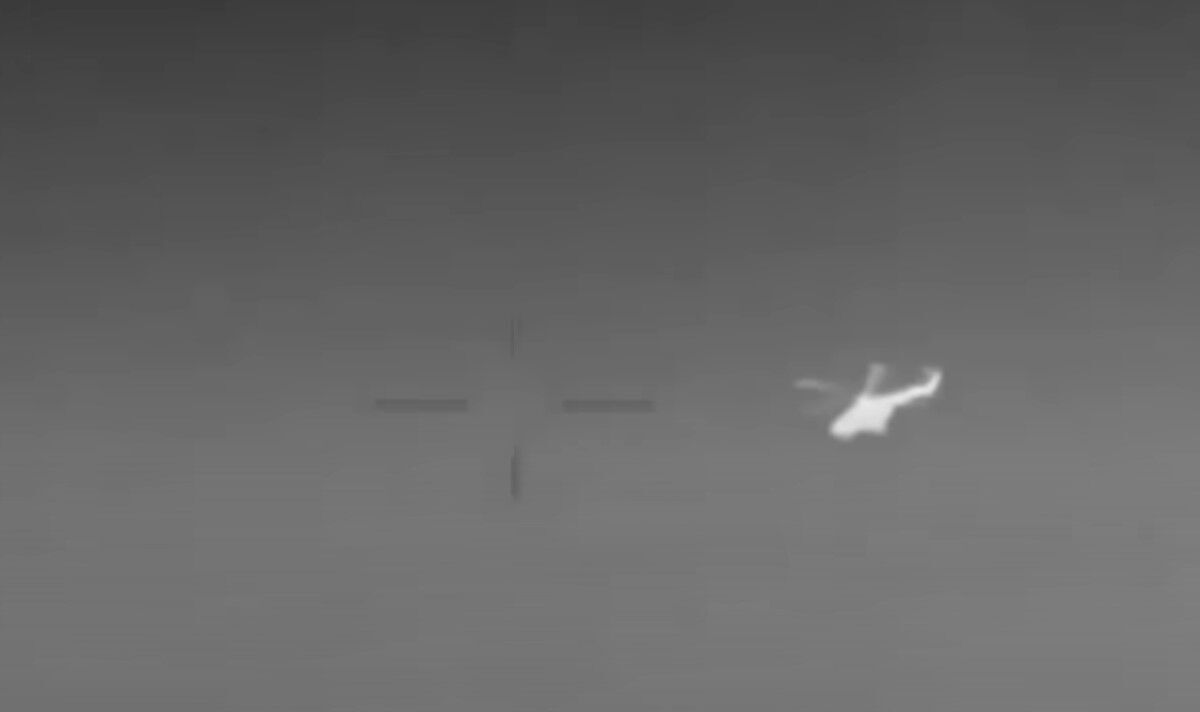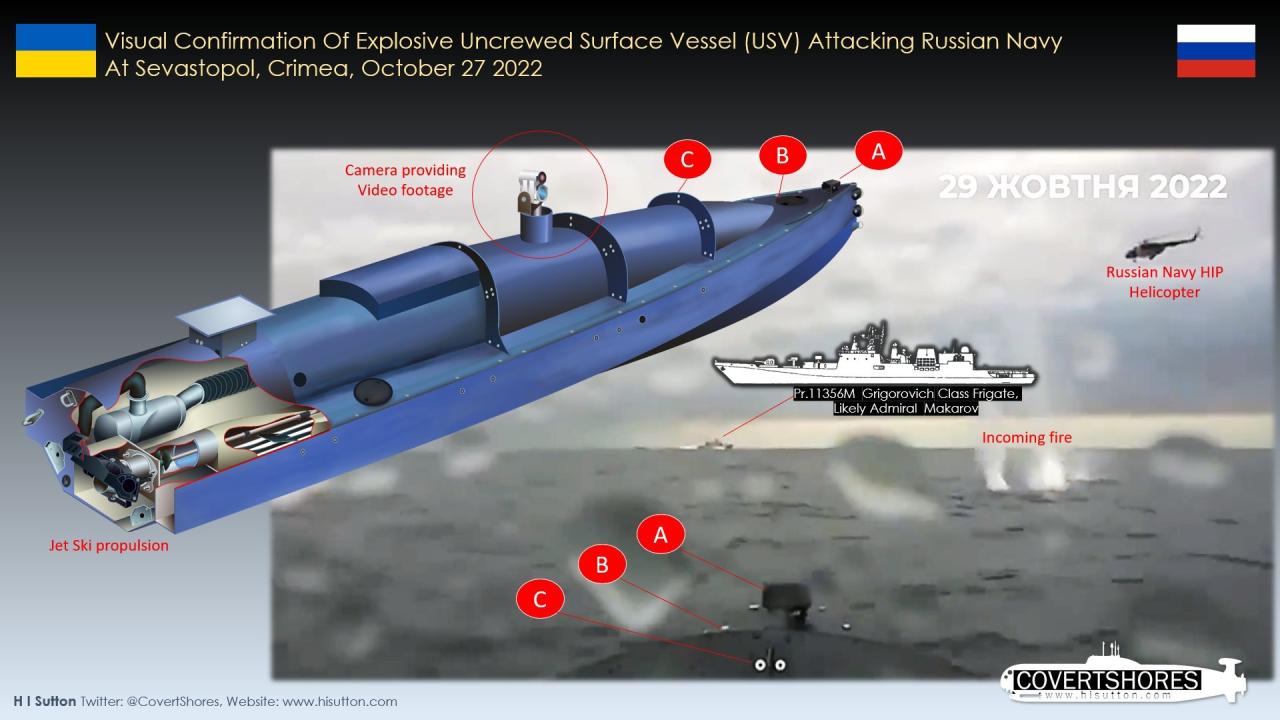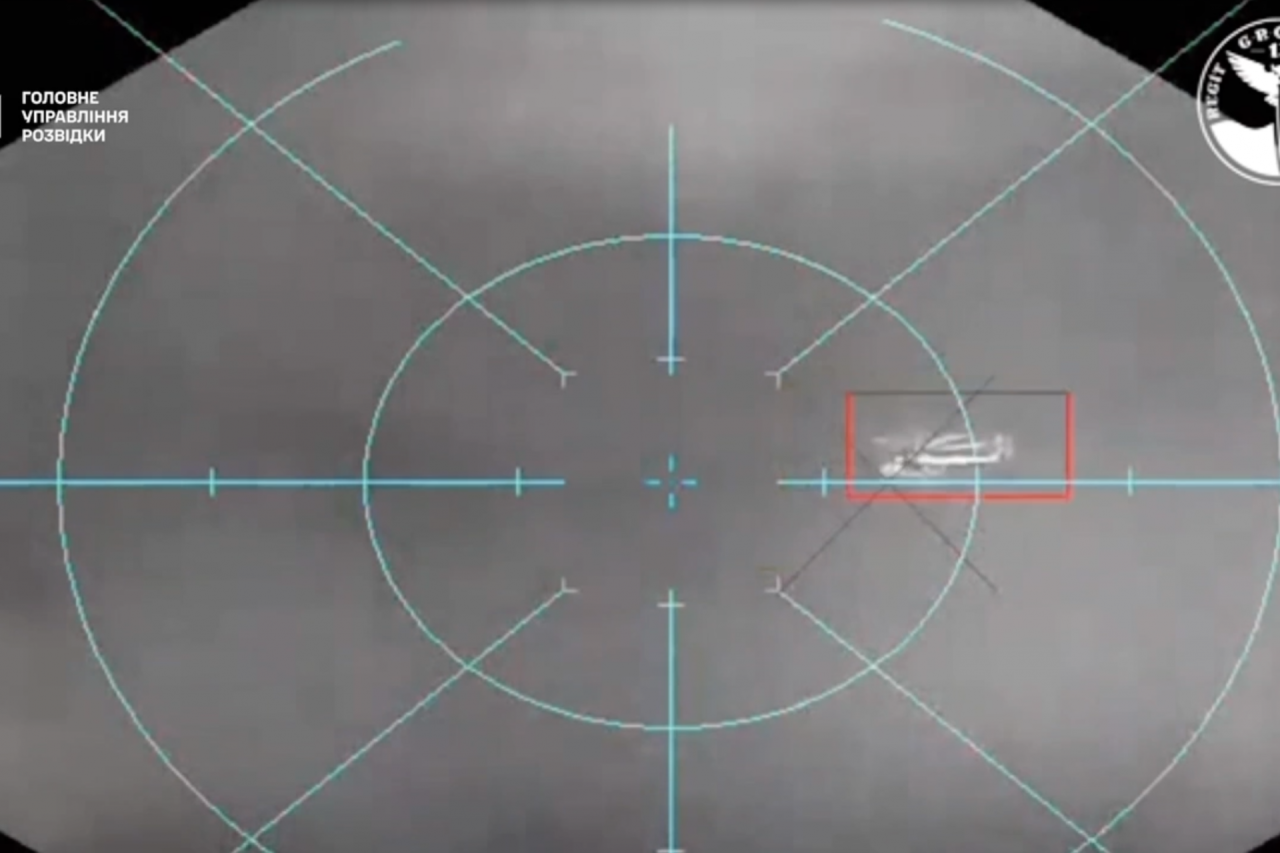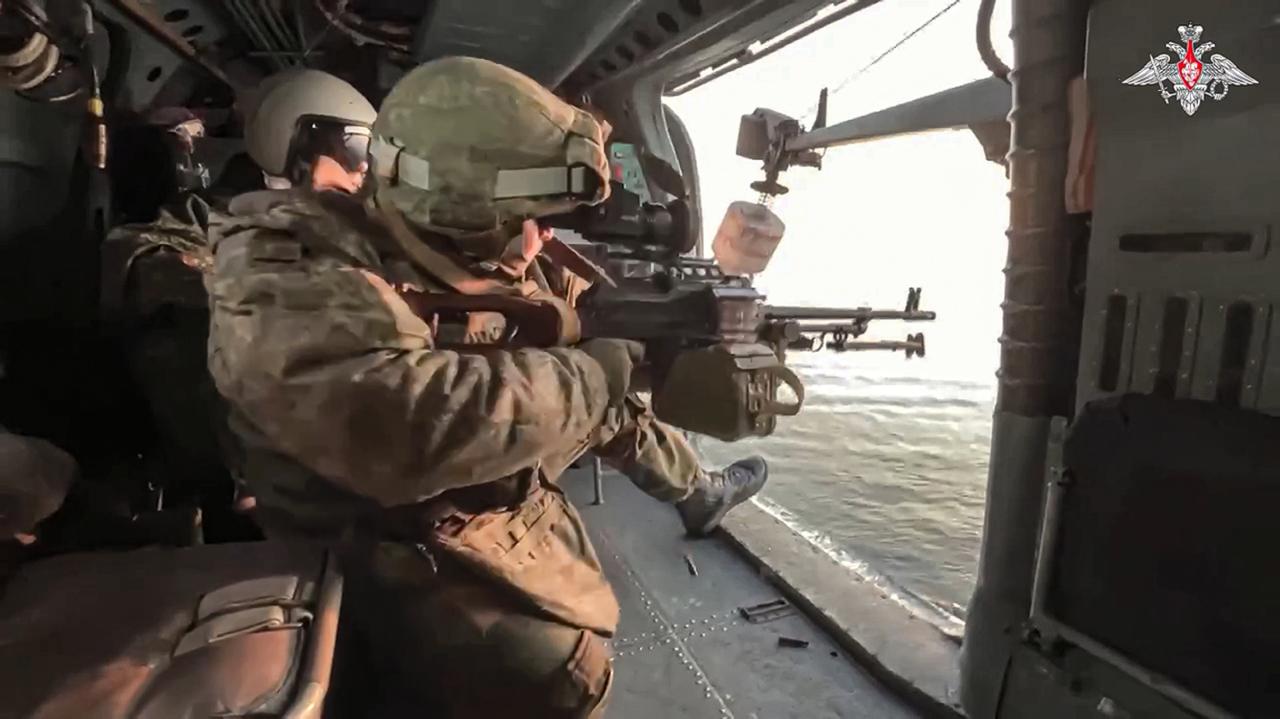Ukrainian sea drones have emerged as a surprisingly effective and adaptable weapon system in the ongoing conflict. These unmanned vessels, ranging from small, expendable craft to more sophisticated autonomous platforms, are changing naval warfare as we know it. This exploration delves into their capabilities, operational use, impact, and future implications, revealing both their strengths and limitations.
We’ll examine the various types of Ukrainian sea drones, comparing their specifications and tactical applications. We’ll also analyze their impact on Russian naval forces, both militarily and psychologically, and consider the international legal and ethical dimensions of their use. Finally, we’ll look ahead to the future of this technology and its potential for wider adoption.
Ukrainian Sea Drone Technology
Ukraine’s burgeoning sea drone program represents a significant shift in naval asymmetric warfare. Leveraging readily available technology and innovative engineering, Ukraine has developed a diverse range of unmanned maritime systems, proving surprisingly effective against a larger, more technologically advanced adversary. However, these systems also face limitations in terms of range, payload, and survivability.
Current State of Ukrainian Sea Drone Technology

Ukrainian sea drone technology is characterized by its adaptability and cost-effectiveness. While lacking the sophisticated sensors and autonomous capabilities of some Western systems, Ukrainian drones compensate with simple designs, ease of production, and effective use of readily available components. This allows for rapid deployment and replacement, crucial in a high-intensity conflict environment. Limitations include shorter operational ranges compared to larger, more expensive drones, and vulnerability to countermeasures like electronic warfare and anti-drone systems.
Comparison with Other Nations’ Sea Drone Technology
Compared to the advanced, often AI-powered autonomous underwater vehicles (AUVs) and unmanned surface vehicles (USVs) fielded by nations like the US, UK, and Israel, Ukrainian sea drones are relatively simpler. However, their effectiveness in a cost-constrained, asymmetric warfare context highlights the importance of adaptability and strategic deployment over sheer technological sophistication. They are arguably more similar to the low-cost, easily-replicated drone systems employed by other smaller nations or non-state actors, but with a higher degree of operational integration within a larger military strategy.
Types of Ukrainian Sea Drones
Ukraine utilizes a variety of sea drones, ranging from small, expendable craft to larger, more sophisticated systems. Specific details are often kept classified, but reports suggest a range of designs optimized for different missions, from reconnaissance and surveillance to delivering explosives.
Specifications of Ukrainian Sea Drones
| Drone Model | Size (approx.) | Payload (approx.) | Range (approx.) | Speed (approx.) |
|---|---|---|---|---|
| Model A (Hypothetical) | Small, boat-like | 50 kg explosives | 50 km | 10 knots |
| Model B (Hypothetical) | Medium, semi-submersible | 100 kg explosives | 100 km | 15 knots |
| Model C (Hypothetical) | Large, surface vessel | 200 kg explosives | 200 km | 20 knots |
Operational Use of Ukrainian Sea Drones
Ukrainian forces have employed sea drones in a variety of ways, demonstrating their adaptability to different tactical situations. Their use reflects a deliberate strategy to exploit cost-effectiveness and asymmetric advantages.
Deployment and Combat Operations
Ukrainian sea drones have been used for reconnaissance missions, targeting Russian naval vessels, and disrupting maritime operations. Their small size and relative quietness allow them to approach targets undetected, maximizing their effectiveness. They are often used in swarms or coordinated attacks to overwhelm defenses.
Successful Missions
While specific details of successful missions are often kept confidential for operational security reasons, reports indicate successful attacks on Russian warships and support vessels, highlighting their impact on naval operations. These attacks have disrupted supply lines and damaged valuable assets.
Logistical Challenges
Deploying and maintaining sea drones in a conflict zone presents significant logistical challenges. These include ensuring a reliable supply of drones, maintaining them in harsh conditions, and coordinating their operations with other military units. The vulnerability of launch and recovery systems to enemy fire also poses a significant risk.
Hypothetical Swarm Operation
Imagine a scenario where a swarm of 50 small, inexpensive Ukrainian sea drones, each carrying a small explosive payload, is launched against a Russian amphibious assault fleet. The swarm overwhelms the fleet’s defensive capabilities, inflicting significant damage and disrupting the planned landing operation. The low cost of the drones makes this a strategically viable tactic even if a significant portion of the swarm is lost.
Impact and Effectiveness: Ukrainian Sea Drone
The impact of Ukrainian sea drone attacks on the Russian Navy has been significant, demonstrating the potential of this technology to disrupt naval operations even against a larger adversary.
Impact on Russian Naval Assets

Reports suggest successful strikes on Russian warships, support vessels, and other naval assets. The cumulative effect of these attacks has undoubtedly hampered Russian naval operations in the Black Sea and potentially affected their overall campaign strategy.
Ukrainian sea drones are making waves with their innovative designs and tactical applications. It’s a far cry from the dazzling spectacle of a drone show, like the amazing shanghai dragon drone show , but both highlight the diverse capabilities of unmanned aerial vehicles. Thinking about the precision and coordination needed for either, you start to appreciate the engineering behind these different types of drones.
Ultimately, both the sea drone and the aerial show drones showcase the rapid advancements in drone technology.
Psychological Impact

The relatively unpredictable nature of sea drone attacks, combined with their potential for inflicting damage, has likely created a significant psychological impact on Russian naval personnel. The constant threat of undetected attacks can erode morale and reduce operational effectiveness.
Limitations and Vulnerabilities
Ukrainian sea drones are not without limitations. Their relatively short range, vulnerability to electronic warfare, and susceptibility to detection by advanced sensors represent significant vulnerabilities. Their effectiveness is also dependent on successful launch and recovery operations.
Cost-Effectiveness
The low cost of Ukrainian sea drones, compared to traditional naval weaponry, makes them a highly cost-effective tool for asymmetric warfare. Their ability to inflict damage disproportionate to their cost makes them a compelling option for resource-constrained militaries.
Future Development and Implications
Future advancements in Ukrainian sea drone technology hold significant implications for naval warfare, potentially reshaping the balance of power at sea.
Potential Advancements
- Increased range and endurance
- Improved payload capacity
- Enhanced sensor technology
- Greater autonomy and AI integration
- Improved countermeasures against anti-drone systems
Implications of Widespread Adoption

Widespread adoption of sea drones could lead to a significant shift in naval warfare, favoring smaller, more agile navies and potentially diminishing the importance of large, expensive capital ships. This could also lead to an escalation in the development of counter-drone technologies.
Ukraine’s innovative sea drones are proving surprisingly effective, showcasing the potential of smaller, autonomous platforms. Think of the advancements – it’s a far cry from the massive, coordinated displays you’ll see at the shanghai drone show 2033 , but the underlying tech shares similar roots. Ultimately, both highlight the rapid evolution of drone technology and its diverse applications, from military operations to dazzling public spectacles.
Future Scenario
Imagine a future naval engagement where a large swarm of advanced Ukrainian sea drones, equipped with sophisticated sensors and AI-controlled navigation, coordinate a complex attack on a Russian naval task force. The drones utilize electronic warfare to suppress enemy defenses, while others infiltrate the task force, targeting critical systems and inflicting significant damage. The visual would depict a chaotic scene of explosions and maneuvering vessels, with the small, agile drones swarming around the larger, more vulnerable warships.
The overall effect would showcase the potential of this technology to change the dynamics of naval warfare.
International Implications
The use of sea drones in warfare raises significant international legal and ethical considerations, with implications for the global arms race and international relations.
Legal and Ethical Considerations
The use of autonomous weapons systems, including sea drones, raises complex legal and ethical questions concerning accountability, proportionality, and the potential for unintended harm. International law needs to adapt to this rapidly evolving technological landscape.
Impact on Global Arms Race
The relative ease and low cost of producing effective sea drones could accelerate the global arms race, particularly among smaller nations and non-state actors. This may lead to a proliferation of these weapons, potentially destabilizing regional security.
International Responses
Different countries have responded differently to the use of Ukrainian sea drones. Some have expressed concerns about the potential for escalation and the implications for international law, while others see them as a legitimate tool for asymmetric warfare.
Ukrainian sea drones are proving surprisingly effective in naval warfare, showcasing the potential of smaller, less expensive platforms. The recent advancements in this technology are a stark contrast to some past aviation mishaps, like the tragic fullerton plane crash , highlighting the critical importance of rigorous safety protocols in all forms of aerial and maritime technology. Understanding these contrasts helps improve the design and deployment of future Ukrainian sea drones.
Timeline of Key Events
A detailed timeline would include key dates related to the development, deployment, and impact of Ukrainian sea drones. This would involve dates of reported successful attacks, announcements of new drone programs, and any significant international reactions or statements regarding their use.
End of Discussion
The rise of Ukrainian sea drones represents a significant shift in naval power dynamics. Their relatively low cost, ease of deployment, and surprising effectiveness have proven them to be a potent tool in asymmetric warfare. While limitations exist, ongoing technological advancements suggest that sea drones will play an increasingly crucial role in future naval conflicts, potentially prompting a reassessment of traditional naval strategies and doctrines.
The impact of this technology extends far beyond the current conflict, shaping the future of naval warfare globally.
Key Questions Answered
How are Ukrainian sea drones powered?
Power sources vary depending on the drone’s size and mission, but common options include batteries and internal combustion engines.
What kind of guidance systems do they use?
Guidance systems range from pre-programmed routes to GPS and more sophisticated AI-assisted navigation.
What is the typical lifespan of a Ukrainian sea drone?
Lifespan is highly variable and depends on the model and mission profile, but many are designed as expendable assets.
How are they deployed?
Deployment methods include launching from shore, smaller vessels, or even larger ships.
